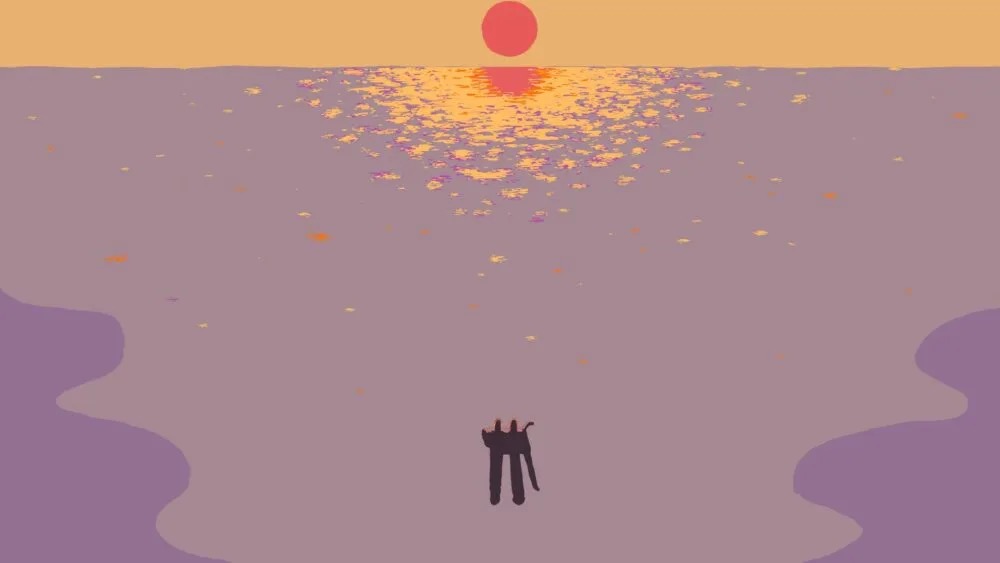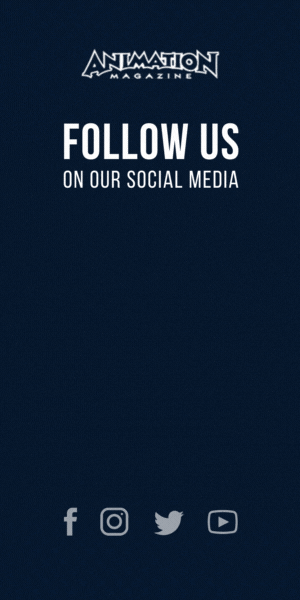An arguing couple are adrift on a log in the ocean and fighting for survival in Levi Stoops’ new animated short, drijf (which translates as float/push). The Belgian artist’s highly stylized short took home the Short Jury Prize the Annecy Animation Festival last week. We had the chance to catch up with the talented Belgian artist right after he took home the big prize. Here is what he told us:
Animation Magazine: Congrats on your big win at Annecy. Can you tell us a bit about the origins of drijf?

Levi Stoops: In an early version of this project there were a lot of things going on with a lot of different characters. There was this Island on the verge of extinction with cannibals and then a couple that fled the Island with the last tree that was left. Eventually I started honing in on this couple because that was the storyline with the least external circumstances. It forced me to really flesh out the characters and tell something relevant about them. In the final version of Drijf there’s still some residual elements of the former idea, like the tree bark. I kept the tree bark because that way they are floating on an amputated object from the beginning of the movie.

What was your inspiration for your short?
I’ve obviously drawn inspiration from survival movies for the action sequences, but I don’t think that’s the most important part of the film. What the film is really about is this couple and the dynamics between them. When I started working with Anemone Valcke, a very good friend of mine and very talented writer and actor, we realized that we should make something about our own relationships. We were both going through similar things with our partners. What we ended up doing is writing from our own toxic behaviors. For me that meant being passive, entitled, emotionally lazy. For Anemone it meant taking the lead, and by doing that, doing the work instead of the other person. It became a story about people who expect different things from each other but never really talk about it. And about how modern, non-macho men exercise power over women. I think for both of us it was an introspective process, and it brought us really close together as friends. In the end we had to take some distance from the characters, to make them go a lot further than we ever would ourselves, and let the fiction take over again.
When did you start working on it and how long did it take to make?
I never wrote full time and I took many breaks, but I think I started writing seven years ago. When production started it took about nine months to complete it, post-production included.

Which animation tools did you use to produce it?
TVPaint only, frame to frame animation. And then some light compositing in After Effects.
What were the hardest part of the job?
Definitely the writing. I think it’s funny, of all the directors, producers and authors I met over time, absolutely no one could explain to me how to write a story. And I don’t think I could explain it to someone myself. It was a difficult process of working hard, getting stuck and then letting go for a while, getting to know myself and trying to be really honest about what I’m trying to convey. And then having some luck finding good and funny ideas, and using those to bring the story further. And then getting stuck again.
What do you love most about the final results?
The way I worked together with other people. I’m really proud of the team. And myself. I tried to be on the floor every day during the production, trying to create a culture with everyone in the team. We really valued the input of everyone who worked on the film, from animator to sound designer. I worked with some of my best friends, and made new friends along the way. We didn’t do unpaid overtime, and adapted the layout and storyboard to the possibilities of the animators with the budget we had. I didn’t want to push the team for excellence and attention to detail at the cost of people getting stressed out or over-worked. It made some parts of the animation really crude, but we found a way to make it work with the humor and the content. That’s what I love the most about the final results. The fact that it turned out great without squeezing the shit out of people.

What would you like audiences to take home for your short?
I would like for them to think about what they expect from their loved ones, and why they do, and have uncomfortable conversations about it. And to not mistake codependency for love. Also, pack sunscreen when you go out to the open sea.
Who are you animation heroes?
David O’Reilly and Don Hertzfeldt. When I start to write a story, I always feel like I am trying to make a Don Hertzfeldt movie. And Nicole Van Goethem. She’s the only Belgian filmmaker to ever win an Oscar (for the short A Greek Tragedy, 1987) but no one in Belgium knows who she is. She made a great short about three women, tired of carrying the crumbling remains of the old world. When it finally falls apart they dance off into the sunset, freed of their burden.
What’s next for Levi?
I’m writing a new short about the difficult connection between men. And after that I would love to write and direct an animated series for adults.
You can watch an interview with Levi below:
And watch the short’s teaser below:












